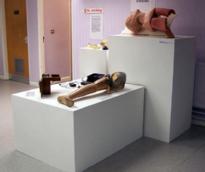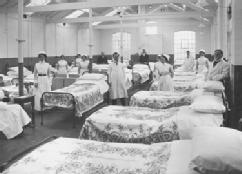The Post-War Era
 The National Health Service
The National Health Service
Between the First and Second World War much of Britain was in deep economic depression. Voluntary hospitals struggled to remain solvent. This provoked debate about the state assuming responsibility for healthcare well before the setting up of the National Health Service in 1948.
Due to the growth of new industries, Coventry suffered less from the depression than other regions. The expansion of voluntary contributions from the workforce through the Hospital Saturday Fund helped to sustain the healthcare needs of the community and funded a new extension to mark the hospital’s centenary in 1938. However, destruction resulting from the wartime aerial bombardment provided a further pressing reason for the government to step in. The wartime spirit of pulling together was a final factor, encouraging enthusiasm for the egalitarianism of a single system of free health care for all Britons.
When it comes to an institution like the Coventry and Warwickshire Hospital, which already had strong links to the community, it is less clear that the NHS heralded a closer relationship between the hospital and the people, as it was thought to have done nationwide. The hospital certainly gained a special place in remembering the shared suffering of the war, however in the post-war years its emotional bond with the population appears to have become more individualised and personal.
In the half-century after the war there was continued expansion – new buildings sprung up around the hospital site, and outposts to handle specific treatments were established across the city – but in the process the original civic grandeur of the hospital faded.
The Decline of ‘Old Hospital’ Medicine
Although hospitals were at the centre of plans for the new National Health Service, it was clear that they were not the same institutions they had been one hundred years earlier. New ideas of health and illness, as well as new approaches to treatment, had taken root.
Expansion in the number of hospital beds reached a peak of nearly half a million in 1960, but then it stopped, and a reversal set in, with a little over a quarter of a million by 1990. A reorientation was taking place, one that had in fact begun long before 1960: people were going into hospital for a shorter length of time. Average length of stay fell from over a month in the mid-nineteenth century, to under a week by the end of the twentieth century. This was a result of greater efficiency, but it also reflected a loss of confidence in the old hospital medicine.
 Confinement within the hospital was no longer viewed as wholly or exclusively therapeutic. This change is apparent in the change of attitude towards the hospital bed – long the key site of medical practice, where bodies were observed and treated. Once thought to offer the therapy of rest and recuperation, from the mid-twentieth century, such confinement was considered potentially dangerous for the patient. Lingering in bed after surgery, for example, raised the possibility of infection, added to which was a growing concern about the dangers and stresses of hospitalisation. Solutions included shorter stays in hospital, a shift to out-patient care where possible, and a more fluid relationship between hospital and community health.
Confinement within the hospital was no longer viewed as wholly or exclusively therapeutic. This change is apparent in the change of attitude towards the hospital bed – long the key site of medical practice, where bodies were observed and treated. Once thought to offer the therapy of rest and recuperation, from the mid-twentieth century, such confinement was considered potentially dangerous for the patient. Lingering in bed after surgery, for example, raised the possibility of infection, added to which was a growing concern about the dangers and stresses of hospitalisation. Solutions included shorter stays in hospital, a shift to out-patient care where possible, and a more fluid relationship between hospital and community health.
Changes to Coventry and Warwickshire Hospital in the post-war era, its fading presence as a grand, civic institution, the decline in bed capacity, and the blurring of boundaries between what went on inside and outside of the hospital walls, mirrored this broader reorientation of hospital medicine.
<- previous stage of exhibition | next stage of exhibition ->
Exhibition tour:
Post-War Era
